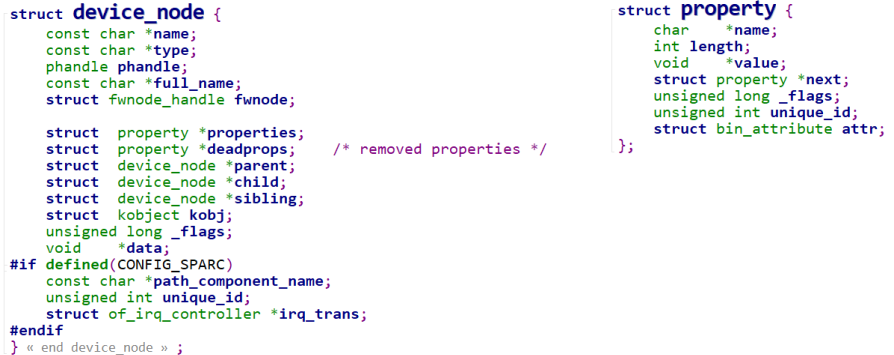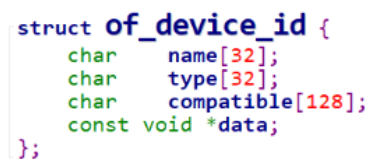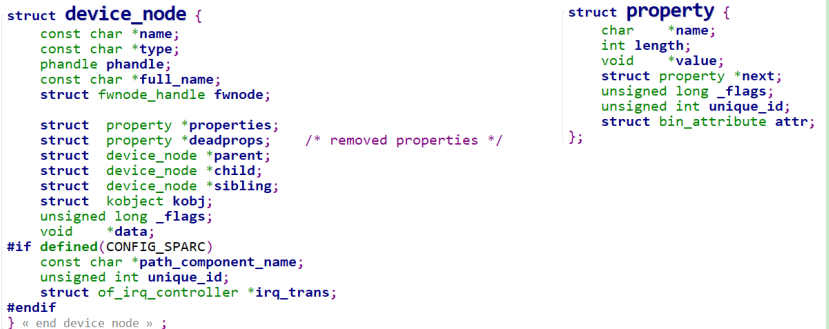1.内核对设备树的处理
从源代码文件 dts 文件开始,设备树的处理过程为:

① dts 在 PC 机上被编译为 dtb 文件;
② u-boot 把 dtb 文件传给内核;
③ 内核解析 dtb 文件,把每一个节点都转换为 device_node 结构体;
④ 对于某些 device_node 结构体,会被转换为 platform_device 结构体。
2.dtb 中每一个节点都被转换为 device_node 结构体

根节点被保存在全局变量 of_root 中, 从 of_root 开始可以访问到任意节点。
3.哪些设备树节点会被转换为 platform_device
3.1 根节点下含有 compatile 属性的子节点 。
3.2 含有特定 compatile 属性的节点的子节点。
如果一个节点的 compatile 属性,它的值是这 4 者之一: "simple-bus","simple-mfd","isa","arm,amba-bus", 那么它的子结点(需含 compatile 属性)也可以转换为 platform_device。
3.3 总线 I2C、 SPI 节点下的子节点: 不转换为 platform_device 。
某个总线下到子节点, 应该交给对应的总线驱动程序来处理, 它们不应该被转换为platform_device。
比如以下的节点中:
/mytest 会被转换为 platform_device, 因为它兼容"simple-bus";它的子节点/mytest/mytest@0 也会被转换为 platform_device。/i2c 节点一般表示 i2c 控制器, 它会被转换为 platform_device, 在内核中有对应的 platform_driver;
/i2c/at24c02 节点不会被转换为 platform_device, 它被如何处理完全由父节点的platform_driver 决定, 一般是被创建为一个 i2c_client。
类似的也有/spi 节点, 它一般也是用来表示 SPI 控制器, 它会被转换为 platform_device,在内核中有对应的 platform_driver;
/spi/flash@0 节点不会被转换为 platform_device, 它被如何处理完全由父节点的platform_driver 决定, 一般是被创建为一个 spi_device。
/ { mytest { compatile = "mytest", "simple-bus"; mytest@0 { compatile = "mytest_0"; }; }; i2c { compatile = "samsung,i2c"; at24c02 { compatile = "at24c02"; }; }; spi { compatile = "samsung,spi"; flash@0 { compatible = "winbond,w25q32dw"; spi-max-frequency = <25000000>; reg = <0>; }; }; };
4.怎么转换为 platform_device
platform_device 中含有 resource 数组, 它来自 device_node 的 reg, interrupts 属性。
platform_device.dev.of_node 指向 device_node, 可以通过它获得其他属性。
5.platform_device 如何与 platform_driver 配对
从设备树转换得来的 platform_device 会被注册进内核里,以后当我们每注册一个platform_driver 时, 它们就会两两确定能否配对,如果能配对成功就调用 platform_driver 的
probe 函数。

其中1.3.4在之前的随笔中已经讨论过了。这边直接讨论2中用设备树匹配。
比较: platform_device. dev.of_node 和 platform_driver.driver.of_match_table。
由设备树节点转换得来的 platform_device 中,含有一个结构体: of_node。
它的类型如下:

如果一个 platform_driver 支持设备树,它的 platform_driver.driver.of_match_table 是一个数组,类型如下:

使用设备树信息来判断 dev 和 drv 是否配对时,
首先,如果 of_match_table 中含有 compatible 值,就跟 dev 的 compatile 属性比较,若一致则成功,否则返回失败;
其次,如果 of_match_table 中含有 type 值,就跟 dev 的 device_type 属性比较,若一致则成功,否则返回失败;
最后,如果 of_match_table 中含有 name 值,就跟 dev 的 name 属性比较,若一致则成功,否则返回失败。
而设备树中建议不再使用 devcie_type 和 name 属性,所以基本上只使用设备节点的compatible 属性来寻找匹配的 platform_driver。
6.没有转换为 platform_device 的节点,如何使用
任意驱动程序里,都可以直接访问设备树,可以使用以下介绍的函数找到节点,读出里面的值。
6.1内核中设备树相关的头文件介绍
内核源码中 include/linux/目录下有很多 of 开头的头文件, of 表示“open firmware”即开放固件。
设备树的处理过程是: dtb -> device_node -> platform_device。
处理 DTB :
of_fdt.h // dtb 文件的相关操作函数, 我们一般用不到, // 因为 dtb 文件在内核中已经被转换为 device_node 树(它更易于使用)
处理 device_node :
of.h // 提供设备树的一般处理函数, // 比如 of_property_read_u32(读取某个属性的 u32 值), // of_get_child_count(获取某个 device_node 的子节点数) of_address.h // 地址相关的函数, // 比如 of_get_address(获得 reg 属性中的 addr, size 值) // of_match_device (从 matches 数组中取出与当前设备最匹配的一项) of_dma.h // 设备树中 DMA 相关属性的函数 of_gpio.h // GPIO 相关的函数 of_graph.h // GPU 相关驱动中用到的函数, 从设备树中获得 GPU 信息 of_iommu.h // 很少用到 of_irq.h // 中断相关的函数 of_mdio.h // MDIO (Ethernet PHY) API of_net.h // OF helpers for network devices. of_pci.h // PCI 相关函数 of_pdt.h // 很少用到 of_reserved_mem.h // reserved_mem 的相关函数
处理 platform_device:
of_platform.h // 把 device_node 转换为 platform_device 时用到的函数, // 比如 of_device_alloc(根据 device_node 分配设置 platform_device), // of_find_device_by_node (根据 device_node 查找到 platform_device), // of_platform_bus_probe (处理 device_node 及它的子节点) of_device.h // 设备相关的函数, 比如 of_match_device
6.2platform_device 相关的函数
of_platform.h 中声明了很多函数,但是作为驱动开发者,我们只使用其中的 1、 2 个。其他的都是给内核自己使用的,内核使用它们来处理设备树,转换得到 platform_device。
函数原型为: extern struct platform_device *of_find_device_by_node(struct device_node *np);
设备树中的每一个节点,在内核里都有一个 device_node;你可以使用 device_node 去找到对应的 platform_device。
函数原型为: /** * platform_get_resource - get a resource for a device * @dev: platform device * @type: resource type // 取哪类资源? IORESOURCE_MEM、 IORESOURCE_REG * // IORESOURCE_IRQ 等 * @num: resource index // 这类资源中的哪一个? */ struct resource *platform_get_resource(struct platform_device *dev,unsigned int type, unsigned int num);
这个函数跟设备树没什么关系, 但是设备树中的节点被转换为 platform_device 后, 设备树中的 reg 属性、 interrupts 属性也会被转换为“resource”。
这时,你可以使用这个函数取出这些资源。
对于设备树节点中的 reg 属性,它属性 IORESOURCE_MEM 类型的资源;
对于设备树节点中的 interrupts 属性,它属性 IORESOURCE_IRQ 类型的资源。
6.3有些节点不会生成 platform_device,怎么访问它们
内核会把 dtb 文件解析出一系列的 device_node 结构体,我们可以直接访问这些device_node。
内核源码 incldue/linux/of.h 中声明了 device_node 和属性 property 的操作函数,device_node 和 property 的结构体定义如下:

6.3.1 找到节点
of_find_node_by_path
static inline struct device_node *of_find_node_by_path(const char *path);
根据路径找到节点,比如“/”就对应根节点,“/memory”对应 memory 节点。
of_find_node_by_name
extern struct device_node *of_find_node_by_name(struct device_node *from,const char *name);
根据名字找到节点, 节点如果定义了 name 属性,那我们可以根据名字找到它。
参数 from 表示从哪一个节点开始寻找,传入 NULL 表示从根节点开始寻找。
但是在设备树的官方规范中不建议使用“name”属性,所以这函数也不建议使用。
of_find_node_by_type
extern struct device_node *of_find_node_by_type(struct device_node *from,const char *type);
根据类型找到节点,节点如果定义了 device_type 属性,那我们可以根据类型找到它。
参数 from 表示从哪一个节点开始寻找,传入 NULL 表示从根节点开始寻找。
但是在设备树的官方规范中不建议使用“device_type”属性,所以这函数也不建议使用。
of_find_compatible_node
extern struct device_node *of_find_compatible_node(struct device_node *from,const char *type, const char *compat);
根据 compatible 找到节点,节点如果定义了 compatible 属性,那我们可以根据compatible 属性找到它。
参数 from 表示从哪一个节点开始寻找,传入 NULL 表示从根节点开始寻找。
参数 compat 是一个字符串,用来指定 compatible 属性的值;
参数 type 是一个字符串,用来指定 device_type 属性的值,可以传入 NULL。
of_find_node_by_phandle
extern struct device_node *of_find_node_by_phandle(phandle handle);
根据 phandle 找到节点。
dts 文件被编译为 dtb 文件时,每一个节点都有一个数字 ID,这些数字 ID 彼此不同。
可以使用数字 ID 来找到 device_node。这些数字 ID 就是 phandle。
参数 from 表示从哪一个节点开始寻找,传入 NULL 表示从根节点开始寻找。
of_get_parent
extern struct device_node *of_get_parent(const struct device_node *node);
找到 device_node 的父节点。
参数 from 表示从哪一个节点开始寻找,传入 NULL 表示从根节点开始寻找。
of_get_next_parent
这个函数名比较奇怪,怎么可能有“next parent”?
它实际上也是找到 device_node 的父节点,跟 of_get_parent 的返回结果是一样的。
差别在于它多调用下列函数,把 node 节点的引用计数减少了 1。这意味着调用of_get_next_parent 之后,你不再需要调用 of_node_put 释放 node 节点。
of_node_put(node); extern struct device_node *of_get_next_parent(struct device_node *node);
参数 from 表示从哪一个节点开始寻找,传入 NULL 表示从根节点开始寻找。
of_get_next_child
extern struct device_node *of_get_next_child(const struct device_node *node,struct device_node *prev);
取出下一个子节点。
参数 node 表示父节点;
prev 表示上一个子节点,设为 NULL 时表示想找到第 1 个子节点。
不断调用 of_get_next_child 时,不断更新 pre 参数, 就可以得到所有的子节点。
of_get_next_available_child
struct device_node *of_get_next_available_child(const struct device_node *node,struct device_node *prev);
取出下一个“可用”的子节点,有些节点的 status 是“disabled”,那就会跳过这些节点。
参数 node 表示父节点;
prev 表示上一个子节点,设为 NULL 时表示想找到第 1 个子节点。
of_get_child_by_name
extern struct device_node *of_get_child_by_name(const struct device_node *node,const char *name);
根据名字取出子节点。
参数 node 表示父节点;
name 表示子节点的名字。
6.3.2 找到属性
内核源码 incldue/linux/of.h 中声明了 device_node 的操作函数,当然也包括属性的操作函数。
of_find_property
extern struct property *of_find_property(const struct device_node *np,const char *name,int *lenp);
找到节点中的属性。
参数 np 表示节点,我们要在这个节点中找到名为 name 的属性。
lenp 用来保存这个属性的长度, 即它的值的长度。
在设备树中,节点大概是这样
xxx_node { xxx_pp_name = “hello”; };
上述节点中,“xxx_pp_name”就是属性的名字,值的长度是 6。
6.3.3获取属性的值
of_get_property
/* * Find a property with a given name for a given node * and return the value. */ const void *of_get_property(const struct device_node *np, const char *name,int *lenp)
根据名字找到节点的属性,并且返回它的值。
参数 np 表示节点,我们要在这个节点中找到名为 name 的属性,然后返回它的值。
lenp 用来保存这个属性的长度, 即它的值的长度。
of_property_count_elems_of_size
* of_property_count_elems_of_size - Count the number of elements in a property * * @np: device node from which the property value is to be read. * @propname: name of the property to be searched. * @elem_size: size of the individual element * * Search for a property in a device node and count the number of elements of * size elem_size in it. Returns number of elements on sucess, -EINVAL if the * property does not exist or its length does not match a multiple of elem_size * and -ENODATA if the property does not have a value. */ int of_property_count_elems_of_size(const struct device_node *np,const char *propname, int elem_size)
根据名字找到节点的属性,确定它的值有多少个元素(elem)。
参数 np 表示节点,我们要在这个节点中找到名为 propname 的属性,然后返回下列结果:
return prop->length / elem_size;
在设备树中,节点大概是这样:
xxx_node { xxx_pp_name = <0x50000000 1024> <0x60000000 2048>; };
调用 of_property_count_elems_of_size(np, “xxx_pp_name”, 8)时,返回值是 2;
调用 of_property_count_elems_of_size(np, “xxx_pp_name”, 4)时,返回值是 4。
6.3.4读整数 u32/u64
of_property_read_u32
of_property_read_u64
static inline int of_property_read_u32(const struct device_node *np,const char *propname,u32 *out_value); extern int of_property_read_u64(const struct device_node *np,const char *propname, u64 *out_value);
在设备树中,节点大概是这样:
xxx_node { name1 = <0x50000000>; name2 = <0x50000000 0x60000000>; };
调用 of_property_read_u32 (np, “name1”, &val)时, val 将得到值 0x50000000;
调用 of_property_read_u64 (np, “name2”, &val)时, val 将得到值 0x0x6000000050000000。
6.3.5读某个整数 u32/u64
of_property_read_u32_index
extern int of_property_read_u32_index(const struct device_node *np,const char *propname,u32 index, u32 *out_value);
在设备树中,节点大概是这样:
xxx_node { name2 = <0x50000000 0x60000000>; };
调用 of_property_read_u32 (np, “name2”, 1, &val)时, val 将得到值 0x0x60000000。
6.3.6读数组
of_property_read_variable_u8_array
of_property_read_variable_u16_array
of_property_read_variable_u32_array
of_property_read_variable_u64_array
int of_property_read_variable_u8_array(const struct device_node *np,const char *propname, u8 *out_values,size_t sz_min, size_t sz_max); int of_property_read_variable_u16_array(const struct device_node *np,const char *propname, u16 *out_values,size_t sz_min, size_t sz_max); int of_property_read_variable_u32_array(const struct device_node *np,const char *propname, u32 *out_values,size_t sz_min, size_t sz_max); int of_property_read_variable_u64_array(const struct device_node *np,const char *propname, u64 *out_values,size_t sz_min, size_t sz_max);
在设备树中,节点大概是这样:
xxx_node { name2 = <0x50000012 0x60000034>; };
上述例子中属性 name2 的值,长度为 8。
调用 of_property_read_variable_u8_array (np, “name2”, out_values, 1, 10)时, out_values中将会保存这 8 个字节: 0x12,0x00,0x00,0x50,0x34,0x00,0x00,0x60。
调用 of_property_read_variable_u16_array (np, “name2”, out_values, 1, 10)时, out_values中将会保存这 4 个 16 位数值: 0x0012, 0x5000,0x0034,0x6000。
总之,这些函数要么能取到全部的数值,要么一个数值都取不到;
如果值的长度在 sz_min 和 sz_max 之间,就返回全部的数值;否则一个数值都不返回。
6.3.7读字符串
of_property_read_string
int of_property_read_string(const struct device_node *np, const char *propname,const char **out_string);
返回节点 np 的属性(名为 propname)的值, (*out_string)指向这个值,把它当作字符串。
7.怎么修改设备树文件
一个写得好的驱动程序, 它会尽量确定所用资源。只把不能确定的资源留给设备树, 让设备树来指定。
根据原理图确定"驱动程序无法确定的硬件资源", 再在设备树文件中填写对应内容。那么, 所填写内容的格式是什么?
有些芯片,厂家提供了对应的设备树生成工具,可以选择某个引脚用于某些功能,就可以自动生成设备树节点。你再把这些节点复制到内核的设备树文件里即可。
看绑定文档。内核文档 Documentation/devicetree/bindings/ ,做得好的厂家也会提供设备树的说明文档。
也可以参考同类型单板的设备树文件 。